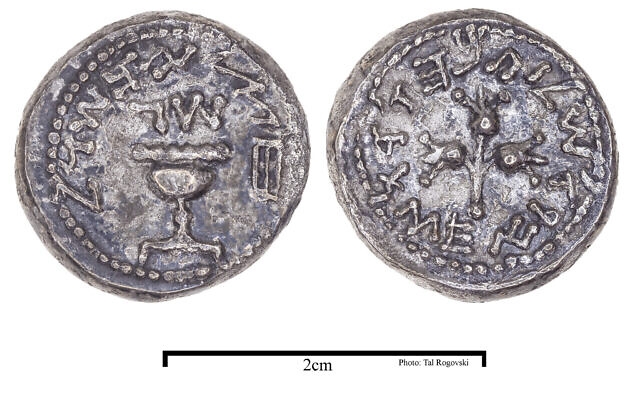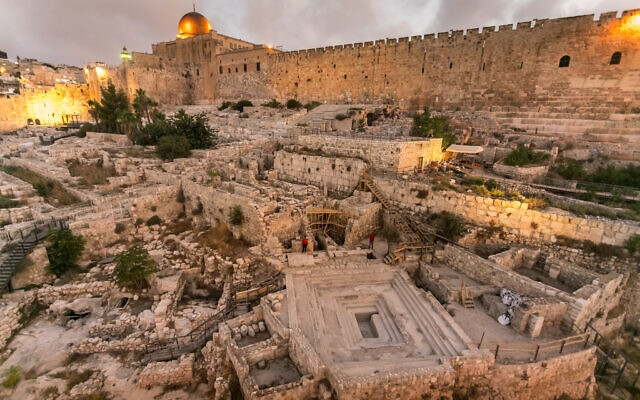
A silver half shekel coin of the third year
of the Great Revolt against Rome,
minted in Jerusalem in 69 CE.
(Israel Antiquities Authority/Tal Rogovski)
Coin found in remains of building from the Second Temple era, was likely used to pay annual tax for worship at the site; most coins of this type are bronze
by TOI Staff
A rare half-shekel silver coin, minted by Jewish rebels nearly 2,000 years ago during the Great Revolt against Roman rule, was recently found during excavations in Jerusalem, the Israel Antiquities Authority said Tuesday.
It was only the third such coin of its type found during excavations in the capital, and among only a handful found in other locations, the IAA said in a statement.
The coin was uncovered at the Ophel site, an area south of the Temple Mount in the Old City, during research on the remains of a public building from the Second Temple era that was apparently also sacked when the Romans, having crushed the revolt, destroyed the Temple in 70 CE.
Excavations at Ophel uncovered dozens of Jewish coins from the Great Revolt, which ran from 66 to 70 CE. Most were made of bronze, but this one was silver and markings showed it was minted in the third year of the rebellion, 69 CE.
Like most coins of this type, there is a cup on one side with an inscription of the coin’s value, together with ancient Hebrew letters above it giving the year it was minted, the IAA said.
The other side bears a branch with three pomegranates and another inscription: "Holy Jerusalem."
The excavation was carried out by a delegation from the Hebrew University’s Institute of Archeology led by Prof. Uzi Liebner, in collaboration with the Armstrong College from Oklahoma in the US. They were assisted by the state-owned company for the development of East Jerusalem, the IAA, and the Israel Nature and Parks Authority.
"This is the third coin of this type that has been discovered in excavations in Jerusalem and one of the few that have been discovered in archaeological excavations in general," Liebner said.
Minting of coins during the rebellion was a political statement and an expression of national liberation, the IAA statement said. At the time, the authority to mint coins was held only by the Roman emperor.
"Indeed, throughout the Roman period until the Great Revolt, no silver coins were minted by Jews at all, not even in the days of King Herod the Great," it said.

Researchers said the coins weighed about seven grams and were used to pay the annual "half-shekel" tax at the Temple for worship costs. Until the uprising, half-shekel coins used for the tax were minted in the Lebanese city of Tyre and bore images of a deity worshiped by locals.
The rebel coins, by removing such gods, were in line with the second of the Ten Commandments, which forbids making graven images of deities.
"The silver coins of the Great Revolt were the first and last in antiquity to bear the name ‘shekel.’ The next time was on the Israeli shekel coins issued by the Bank of Israel in 1980," researchers said.
According to a Monday statement from the Armstrong Institute, the precious silver coins are believed to have been minted inside the Temple complex.
 Only in Israel
Only in Israel
 Life in Israel Articles
Life in Israel Articles
 Chanuka Hotsites
Chanuka Hotsites

 Chanukah Videos
Chanukah Videos

 JR Links
JR Links